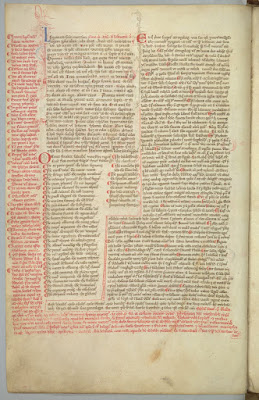- Scribe(s)
The Digital Scriptorium (Scriptorium, 2011) noted that the manuscript was created using two scribes. The first scribe created the breviary, Simon of Genoa, “The Recluse”. The second scribe created the Marian prayers and is unknown and no other information was found.
The catalog of music pre- 1900 vocal manuscripts in the music library, University of California at Berkeley does not mention any other scribe having worked on the manuscript other than Simon of Genoa (Emerson, 1988) .
 |
| Simon of Genoa? |
- Ink
The type of ink used to create the Camaldoli manuscript is not identified from the present research available, but speculating what choice of ink Simon the Recluse, might have used can be done.
He had two choices available to him at the time he copied the breviary. The first being a metallic ink, made from mixing the tannic acid of oak galls, organic iron salts, which provided the color black or grey, and gum Arabic (Avrin, 1991, p. 214) . Unfortunately, this type of ink fades or disappears over time. The Camaldoli manuscripts ink is still present and very dark in color, therefore Simon may have chosen to use the second choice of ink.
The recipe for the second type of ink, from a fellow monk Theophilus, was created in 1100. The process involved soaking the bark from the thorns of a blackthorn tree for three days; the reddish-brown water was then boiled and then re-combined with the bark. This step was repeated a few times, with the final step being to combine the liquid with wine and boil the mixture. The liquid was then dried in sun (Avrin, 1991, p. 214) . Simon and his monastery were deep in the forest and had the ingredients in abundance, so this choice while a lengthy process to create, seems to be the most likely choice for Simon to use while copying the manuscript.
- Rubrication
There are examples of rubrication throughout the Camaldoli manuscript. The red and blue alternating headings and titles are used to identify texts and give instruction to the readers (Brown, 1994, p. 111) . The most common found are the 1 in. initials that start at the top of the folio or are dispersed in the body of the text to begin a new section and the initials that serve as prompts located at the beginning of lines within the body of the text.

- Decoration
- Illumination/Painting
Illumination, the art of bringing light or illuminating a manuscript with luminous colors, such as gold or silver, is not present in the Camaldoli manuscript. While there are many beautifully embellished initials and letters in the text, Simon of Genoa, did not further the embellishment by illuminating any of them (Brown, 1994, p. 6)
- Scripts
The Camaldoli manuscript was written in the popular script of the time, Gothic. The characteristics of the script used in the Camaldoli manuscript are letters that are more angular and compressed. The scripts angles and construction mimicked the gothic cathedral architecture of the time. Also, some characters also show hairline flourishes or other decorations, another attribute of Gothic script. Simon’s work shows use of uncials for ‘D’ and that he used a slanted stroke over the ‘I’ to distinguish it from nearby ‘m’, ‘n’, and ‘u’ (Avrin, 1991, pp. 191-193) .
As a chant book, the Camaldoli manuscript has many examples of musical notations throughout the text. The notations are neumes, or graphic symbols above the text identifying the rise and fall of the melody or the repetitions of a pitch (Brown, 1994, p. 89) . The quadratic or square neumes in the Camaldoli manuscript are in black ink and set above the text on a staff of four 4 read lines.







